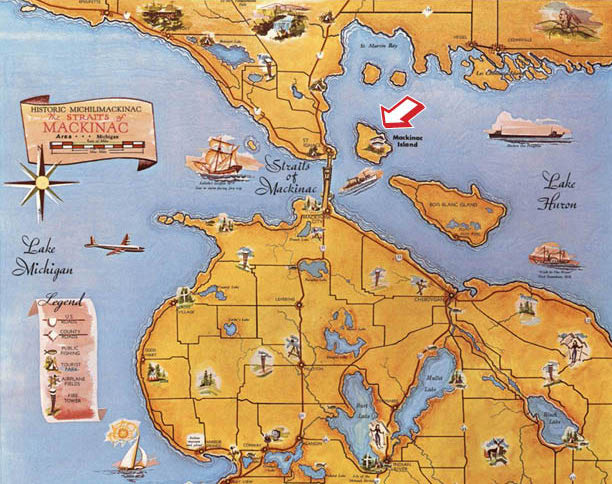Sign up for the Family Tree Newsletter Plus, you’ll receive our 10 Essential Genealogy Research Forms PDF as a special thank you!
Get Your Free Genealogy Forms
"*" indicates required fields
On a trip to Michigan last month, I got the chance to visit Mackinac Island at the tip of the mitten. It’s famous for being vehicle-free. No traffic noise, parking lots, or busy intersections to cross. You get around on foot, bike or horse-drawn carriage.
* See our Michigan genealogy research tips. *

Fort Mackinac
One of the island’s attractions is a military fort more than 200 years old, built on bluffs overlooking the town and harbor.
I learned that despite that final c, “Mackinac” is pronounced MackinAWE. Mackinaw City on the mainland makes things easier by spelling the name like it sounds.
The British began building Fort Mackinac in 1780 to watch over the Straits of Mackinac, which connect lakes Michigan and Huron. After the American Revolution, the 1783 Treaty of Paris made the fort US property. Still, Britain didn’t hand it over until 1796.
Fort Mackinac in the War of 1812
The “second war of independence,” the War of 1812, began in June 1812. On July 17, British troops and their American Indian allies surprised the small garrison at Fort Mackinac. The Americans at the remote fort hadn’t heard from their superiors in months.
The outnumbered soldiers surrendered and the British occupied the fort. They fended off a US attempt to retake the fort in the Battle of Mackinac Island, in August 1814.
The war ended, and Americans got the fort back. They didn’t use it much, and abandoned it for stretches. It did hold three Confederate POWs during the Civil War, two of whom signed loyalty oaths to the Union rather than endure a Great Lakes winter.
Visiting Fort Mackinac
A national park (the country’s second, after Yellowstone) encompassed the fort starting in 1875, with troops stationed there acting as park rangers. Assignment to Fort Mackinac was relatively pleasant. as the island was becoming a popular as summer resort.
Congress closed the park and fort in 1895, transferring both to the state of Michigan.
It’s now a popular tourist destination. You can walk inside 14 buildings constructed over the years, all restored to their late 1800s appearance. Those include three blockhouses, barracks, a bathhouse, commissary, officers’ quarters, canteen, guardhouse, schoolhouse, storehouse, and post headquarters. If your ancestor served here—what a great opportunity to see how he lived!
Need a virtual tour? The Fort Wiki has good photos of each building.
Did your military ancestor serve at Fort Mackinac?
There’s a computer at the fort where you can search for your relative’s name and get information about him. If you visit, you can research at the Mackinac State Historic Park’s Petersen Research Library.
I couldn’t find the same soldier database online, but you can get at the info in other sources:
- A complete guide to researching military service records is downloadable from the Family Tree Shop.
- Find info and officers’ names in the 1894 Annals of Fort Mackinac on the free Internet Archive.
- Ancestry has the above book, too, as well as several others about the fort and Mackinac island.
- Here’s a listing of Fort Mackinac officers, compiled in 1883.
- Look for the book The Soldiers of Fort Mackinac: An Illustrated History by Phil Porter (Michigan State University Press).
ADVERTISEMENT
